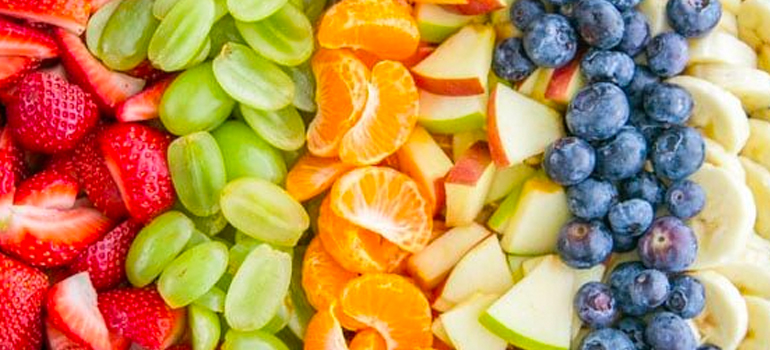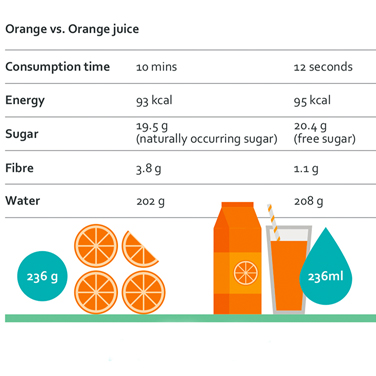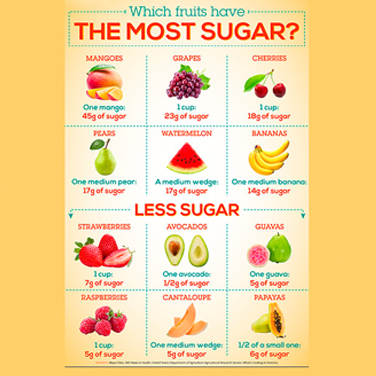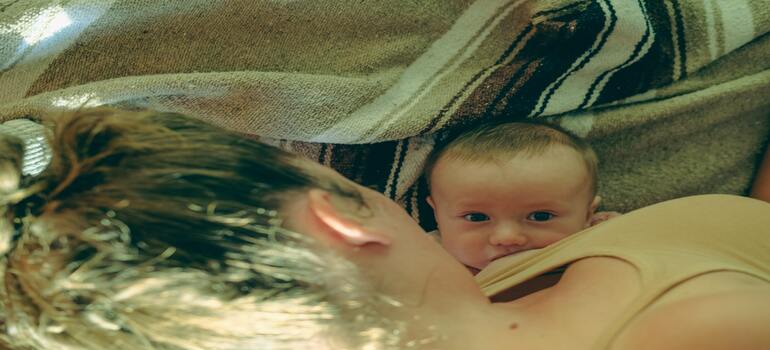How Much Sugar Is There In Fruits?

- October 9, 2020
- MKB Team
Is the Sugar in Fruits Harmful for your Child?
Eat your fruits, eat your greens! This is the wisdom that has been passed on for centuries as a family heirloom. But, is this really wisdom? Motherhood today is all about making well informed choices and not believing in blindly following anything when it comes to your baby. Yes, fruits are great for your baby! But, you need to get your hands a little fruity and dive into a few important facts. Let’s get started!
1. Sucrose
Sucrose is the scientific name for table sugar. Sucrose consists of one glucose and one fructose molecule, or 50% glucose and 50% fructose. It’s a naturally occurring carbohydrate found in many fruits, vegetables and grains, but it’s also added to many processed foods, such as candy, ice cream, breakfast cereals, canned foods, soda and other sweetened beverages.
Sucrose tastes less sweet than fructose but sweeter than glucose.
2. Glucose
Glucose is your body’s preferred carb-based energy source. It is less sweet than fructose and sucrose. Glucose is absorbed directly across the lining of the small intestine into your bloodstream, which delivers it to your cells.
It raises blood sugar more quickly than other sugars,which stimulates the release of insulin.
3. Fructose
Fructose or “fruit sugar,” is naturally found in fruits, honey, agave and most root vegetables. Moreover, it’s commonly added to processed foods in the form of high-fructose corn syrup.Fructose is sourced from sugar cane, sugar beets and corn. Of the three sugars, fructose has the sweetest taste but least impact on your blood sugar. Like glucose, fructose is absorbed directly into your bloodstream from the small intestine. It raises blood sugar levels more gradually than glucose and does not appear to immediately impact insulin levels. However, even though fructose doesn’t raise your blood sugar right away, it may have more long-term negative effects. Your liver has to convert fructose into glucose before your body can use it for energy. Excessive fructose intake may also raise the risk of metabolic syndrome and non-alcoholic fatty liver disease
Sugar in Fruits :
Fruits have fructose, glucose and a combination of the two : sucrose. But, the sugars in fruit are packed less densely than, say in a candy bar.
A can of soda, for example, has about 40 grams of sugar. But, what else are you getting with that? You're getting no protein, no minerals and no fibre. You get nothing but the sugar and the calories. A serving of fruit, by contrast, usually contains no more than 20 grams of sugar, has fibre and has nutrients like vitamin C. You're getting a lot of bang for your buck. And fibre and lower sugar amounts can also decrease sugar spikes in blood levels.
That doesn't mean there aren't possible pitfalls for fruit freaks? Dried fruits tend to pack more sugar into a bite because they're so concentrated. The way any fruit is consumed changes the nutrient count entirely. Refer to the chart below to know how the same fruit orange has such diverse numbers when consumed as a fruit & when consumed in the form of juice.

What is the RIGHT amount of fruits for your baby?
To keep things simple, think of a medium-sized fruit, such as an apple or banana as serving, or two to three smallish items, such as kiwi or strawberries. If your child is eating more than two servings, they may face complications, including:
- Bloating or Other Intestinal Distress: Fruits are high in the natural sugar fructose, which many people find hard to digest. In many, this sugar isn’t fully digested when it reaches the small intestine, where it’s seized by bacteria. This can cause gas or bloating.
- Sugar Cravings: It’s counterintuitive, but eating fruit may cause your child to crave sugar. Fructose spikes blood sugar levels, but they return to normal quickly, leaving kids craving another quick boost of energy.
- Too Much Fiber: Fruits are a great source of fiber, which is an important part of kids’ diets – in reasonable amounts. Fiber can interfere with absorption of vitamins and minerals.

Although mango has a lot of nutritional qualities, the amount of sugar just makes it a red flag fruit. Out of all the fruits, mangoes have the most sugar content. One single mango on an average has a whooping 45grams of sugar. So ladies, sadly the king of fruits also the king of sugar; making it a fruit to watch out for when it comes to both you as a mom & your baby to assure a sane sugar level.
To ensure a healthy diet, make sure you babies eat whole foods whenever possible and save added sugars for the occasional special treat.
Published by
MKB Team
200 Articles
MomsKnowBest is a fast-growing vibrant community of moms, for moms, by moms. Motherhood is complex fun, fulfilling, grueling, exhausting and very complex. There’s no handbook to it. And let’s face it – moms are put...
Read MoreShare with your friends!
Leave a Comment
Trending Post
Myth Buster: Having iron tablets makes your child...
Busting Top 10 Pregnancy Myths about having Iron Tablets
One of the Top 10 pregnancy myths is that...
Health Benefits of Pomelo For Moms To-Be & Kids
During pregnancy, women need proper nutrition to support their health as well as the growth of the...



